| Family |
Species |
Author |
Info |
Occurrence |
Common names |
Abundance |
Max length |
Maturity |
Remark |
Photo |
| Pleuronectidae |
Liopsetta pinnifasciata
|
(Kner, 1870) | Fr, Br, M
| native | Polosataya kambala (Russian), Arctic flounder (English), Far Eastern smooth flounder (English), Striped flounder (English), Dal'nevostochnaya gladkaya kambala (Russian) | | 50.00 cm SL male/unsexed | | Distributed in the southern part of the Sea of Okhotsk, the Amur estaury and near south Sakhalin. Enters the lower reaches of rivers flowing into Peter the Great Bay and the mouth of the Lyutoga River in Sakhalin (Ref. 26334). nEurRus | 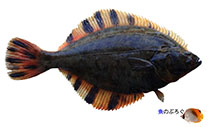 |
| Lotidae |
Lota lota
|
(Linnaeus, 1758) | Fr, Br, Fi
| native | Налим (Russian), Evropeyski nalim (Russian), Burbot (English), Thin-tailed burbot (English), Sylyhar (Russian), налим (Russian) | common (usually seen) | 152 cm TL male/unsexed | 47.5 TL | Found in the Kolyma, Anadyr and Penzhina rivers in the east, in Lake Baikal, Sakhalin, the Shantars, and the rivers of Novosibirsk islands (Ref. 26334). Occurs in the Amur river basin (Ref. 13397). Found also in the basins of the Poronai and Tym' Rivers (Ref. 27681), Don (Ref. 58293), Onega (Ref. 55804), Volga (Ref. 58297). Introduced in Kuban River drainage but means of introduction, pathways or results of invasion are uncertain (Ref. 45022, 58296). Also Ref. 1371, 37812, 43202, 55804. EurRus | 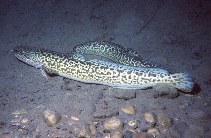 |
| Cyprinidae |
Luciobarbus brachycephalus
|
(Kessler, 1872) | Fr, Br, Thr
| native | Aral'skii usach (Russian), Aral'skiy usach (Russian), Aral barbel (English), Kayaz (Kazakh), Sugön (Kazakh) | | 90.00 cm TL male/unsexed ;105 cm TL female | | Occurs in the basins of the Caspian and Aral seas (Ref. 26334). This has been translocated to areas within the country for stocking in open waters however, it failed to establish populations in areas where it has been transplanted to (Ref. 45022). There is sharp decline of stocks due to massive habitat alterations (Ref. 59043). Also Ref. 683. EurRus |  |
| Cyprinidae |
Luciobarbus capito
|
(Güldenstädt, 1773) | Fr
| native | Turkestanskii usack (Russian), Usach bulat-mai (Russian), Bulat-mai barbel (English), Bulatmai barbel (English), теньге-балик (Russian), усач булат-маи (Russian), усач булат-май (Russian), усач туркестанский (Russian) | | 105 cm TL male/unsexed | | Occurs in the Terek (including the Sunzha), Samur, Kayakent, Rubas-chai and very rarely in the Volga (Ref. 26334). Also Ref. 59043. EurRus |  |
| Cyprinidae |
Luciobarbus caspius
|
(Berg, 1914) | Fr, Br
| native | Kaspiiskii usach (Russian), Caspian barbel (English), усач каспийский (Russian), ширбит (Russian) | | 120 cm TL male/unsexed | | Spawns in Ural (Ref. 26334). EurRus | No picture yet. |
| Cyprinidae |
Luciobarbus escherichii
|
(Steindachner, 1897) | Fr
| questionable | | | 23.00 cm TL male/unsexed | | Outside distributional range. Occurrence needs confirmation. | 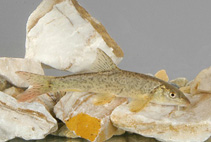 |
| Osphronemidae |
Macropodus ocellatus
|
Cantor, 1842 | Fr
| native | | | 8.60 cm TL male/unsexed | | Occurrence in the Amur basin is probably the result of introductions (Ref. 42924). In Amur, historicallly known only from Sungari; reported in 1993 from Khabarovsk (Ref. 82587). nEurRus | 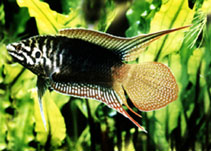 |
| Osphronemidae |
Macropodus opercularis
|
(Linnaeus, 1758) | Fr
| native | Makropod (Russian), макропод (Russian) | | 6.70 cm SL male/unsexed | | Known from the Amur River drainage (Ref. 58298). nEurRus | 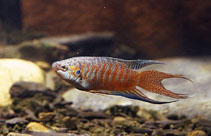 |
| Osmeridae |
Mallotus villosus
|
(Müller, 1776) | Fr, Br, M, Fi
| native | Мойва (Russian), Moiva (Russian), Moyva (Russian), Capelin (English), мойва (Russian) | common (usually seen) | 20.00 cm TL male/unsexed ;25.20 cm TL female | 9.5 TL | Found from Cape Nizkiy on the Korak Coast (northeast of Cape Olyutorksi) north throughout the Anadyr Gulf in western Bering Sea, northeast of Cape Lisburne in the Chukchi Sea south throughout eastern Bering Sea. Southeastern Sakhalin, Kamchatka (Ref. 37812), northern Primor'ye shelf (Ref. 45905). Often entering brackish and freshwater (Ref. 37812). Also Ref. 6885, 276, 6793, 27436, 27683, 123027. nEurRus |  |
| Xenocyprididae |
Megalobrama mantschuricus
|
(Basilewsky, 1855) | Fr
| native | Black Amur bream (English) | | 37.70 cm male/unsexed | | Known from the Amur River (Ref. 58298, 82587). Also Ref. 51498. nEurRus | No picture yet. |
| Xenocyprididae |
Megalobrama terminalis
|
(Richardson, 1846) | Fr
| native | Chernyi amurskii leshch (Russian), Chernyi lesch (Russian), Black Amur bream (English), черный амурский лещ (Russian) | | 60.00 cm TL male/unsexed | 30 TL | Occurs in the Ussuri, Lake Khanka and the lower reaches of the Amur (Ref. 26334). nEurRus | 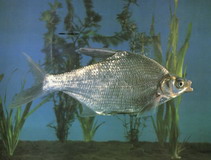 |
| Cottidae |
Megalocottus taeniopterus
|
(Kner, 1868) | Fr, Br, M
| endemic | Yuzhnaya ploskogolovaya shirokolobka (Russian), Southern flathead sculpin (English) | common (usually seen) | | | Distributed in the Amur Liman, Peter the Great Bay, and South Sakhalin (Ref. 2058). Found also in the basins of the Poronai and Tym' Rivers (Ref. 27681). nEurRus | No picture yet. |
| Cottidae |
Mesocottus haitej
|
(Dybowski, 1869) | Fr
| native | амурская широколобка (Russian), подкаменщик-широколобка (Russian), уссурийский подкаменщик (Russian) | | 20.00 cm TL male/unsexed | 11 TL | Type locality: Onon and Ingoda rivers and their tributaries (Ref. 26282). Distributed in the Amur basin from the upper reaches to the estuary, the Sungari and Ussuri basins, rivers in northern Sakhalin and the Yaludzyan River (Ref. 26334). nEurRus | No picture yet. |
| Gobiidae |
Mesogobius batrachocephalus
|
(Pallas, 1814) | Fr, Br
| native | Bychok-knut (Russian), Toad goby (English) | | 35.00 cm SL male/unsexed | | Occurs in the Sea of Azov up to the mouth of the Don and along the entire Caucasian coast of the Black Sea (Ref. 26334). EurRus |  |
| Odontobutidae |
Micropercops cinctus
|
(Dabry de Thiersant, 1872) | Fr
| native | | | 8.00 cm TL male/unsexed | | Known from the Amur basin. Only two specimens are known from Amur basin: one from Yalu Ho River (a tributary of the Nonni River) and the other one in a tributary of the Sungari (Ref. 26334). Also Ref. 74657. nEurRus |  |
| Gobionidae |
Microphysogobio amurensis
|
(Taranetz, 1937) | Fr
| native | Amur longnose gudgeon (English) | common (usually seen) | 11.50 cm TL male/unsexed | | Occurs in the middle and lower Amur River and Khanka Lake (Ref. 13397). Also Ref. 1441, 26334. nEurRus | No picture yet. |
| Gobionidae |
Microphysogobio tungtingensis
|
(Nichols, 1926) | Fr
| native | Long-nosed gudgeon (English), носатый пескарь (Russian) | | 11.50 cm SL male/unsexed | 4 TL | Found throughout the entire Amur basin: the Shilka, Argun, Amur and Ussuri rivers and Lake Khanka (Ref. 26334). nEurRus | No picture yet. |
| Centrarchidae |
Micropterus salmoides
|
(Lacepède, 1802) | Fr
| introduced | Форелеокунь (=окунь большеротый черный) (Russian), Bol'sherotyi chernyi okun' (Russian), Largemouth bass (English), большеротый американский окунь (Russian), окунь большеротый (Russian) | | 97.00 cm TL male/unsexed | | Was Stocked in the Abrau and Limanchik lakes near Novorossisk as well as in the vicinity of Moscow (Ref. 26334, 2058). Also Ref. 683. EurRus |  |
| Cobitidae |
Misgurnus anguillicaudatus
|
(Cantor, 1842) | Fr
| native | Вьюн восточный (Russian), Amurskii v'yun (Russian), Vostochnyi (Russian), Amur mud loach (English), Amur weatherfish (English), Japanese weatherfish (English), Oriental weatherfish (English) | | 28.00 cm SL male/unsexed | | Inhabits the Amur basin, Sakhalin and rivers in Primor'e (Ref. 26334) and Lake Khanka basin (Ref. 13397). Found also in the basins of the Poronai and Tym' Rivers (Ref. 27681). Also Ref. 37812. nEurRus |  |
| Cobitidae |
Misgurnus fossilis
|
(Linnaeus, 1758) | Fr
| native | Вьюн обыкновенный (Russian), V'yun obyknovennyi (Russian), Mud loach (English), вьюн (Russian) | occasional (usually not seen) | 30.00 cm TL male/unsexed ;30.70 cm TL female | | Inhabits the basins of the Don and Volga rivers and the basin of the Baltic Sea (Ref. 26334). EurRus | 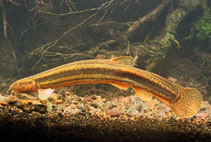 |
| Cobitidae |
Misgurnus mohoity
|
(Dybowski, 1869) | Fr
| native | | | 18.30 cm TL male/unsexed | | Type locality, Lakes of Onon and Ingoda river system, Amur R. basin, Russia (Ref. 46206). nEurRus | 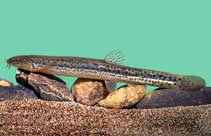 |
| Cobitidae |
Misgurnus nikolskyi
|
Vasil'eva, 2001 | Fr
| native | | | 13.70 cm TL male/unsexed ;15.60 cm TL female | | Found at the Ob floodplain, Novosibirsk raion and Iskitimskii raion, south of western Siberia (Ref. 85151). nEurRus | No picture yet. |
| Moronidae |
Morone saxatilis
|
(Walbaum, 1792) | Fr
| introduced | Polosatyi lavrak (Russian), полосатый окунь (Russian) | | 200 cm TL male/unsexed | | This has been introduced to the country for stocking in open waters. It has locally established in the country (Ref. 45022). nEurRus |  |
| Mugilidae |
Mugil cephalus
|
Linnaeus, 1758 | Fr, Br, M
| introduced | Loban (Russian), Striped mullet (English), лобан (Russian), черная кефаль (Russian) | | 100.00 cm SL male/unsexed | 35 TL | Found in the coastal waters of Primor'e and Sakhalin, and the Tatar Strait (Ref. 26334). Recorded from Kuban River (Ref. 58296). Introduced into Caspian Sea (Ref. 2804). Also Ref. 6375, 37812. EurRus |  |
| Xenocyprididae |
Mylopharyngodon piceus
|
(Richardson, 1846) | Fr, Fi
| native | Амур черный (Russian), Tschernyi Amur (Russian), Black amur (English), Chinese roach (English), амур черный (Russian), черный амур (Russian) | | 180 cm TL male/unsexed | 70 TL | Occurs in the Ussuri, Lake Khanka, and the Amur below Khabarovsk from the confluence of the Sungari to Novoil'inka and Lake Udyl (Ref. 26334). This has been translocated to areas within the country for aquaculture and stocking in open waters, but failed to establish populations (Ref. 45022). Native stocks have declined sharply (Ref. 59043). nEurRus | 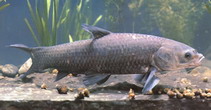 |
| Cottidae |
Myoxocephalus quadricornis
|
(Linnaeus, 1758) | Fr, Br, M
| native | Alyaskinskaya rogatka (Russian), Four-horned sculpin (English), Ledovito-morskaja rogatka (Russian), Rogatka (Russian), четырехрогий бычок (Russian), Alaska fourhorn sculpin (English) | common (usually seen) | 60.00 cm TL male/unsexed | | Occurs in the lakes of Karelia, in lakes Ladoga and Onega, and in some lakes in the Taimyr Peninsula. It is frequently found in the Baltic and White seas. It inhabits the mouths of rivers flowing into the Arctic Ocean; as well south of the Bering Strait up to the Anadyr estuary (Ref. 26334). Also Ref. 123027. EurRus |  |
| Cottidae |
Neocottus thermalis
|
Sideleva, 2002 | Fr
| endemic | | | | | Found in Lake Baikal (Ref. 58294). nEurRus |  |
| Cottidae |
Neocottus werestschagini
|
(Taliev, 1935) | Fr
| endemic | | | 9.80 cm TL male/unsexed | | Found only in Lake Baikal (Ref. 26334). Also Ref. 2058, 58294. nEurRus |  |
| Gobiidae |
Neogobius fluviatilis
|
(Pallas, 1814) | Fr, Br
| native | Babka (Russian), Monkey goby (English), Sand goby (English), Bychok-peschanik (Russian), бычок белый (Russian), бычок-песочник (Russian), песчаник (Russian) | | 20.00 cm SL male/unsexed | | Occurs in the Dnieper, Don, Kuban, rivers of the Black Sea coasts, regions with low salinity along the Caspian coasts, and the Volga Delta (Ref. 26334). EurRus |  |
| Gobiidae |
Neogobius melanostomus
|
(Pallas, 1814) | Fr, Br, Fi
| native | Ginger goby (English), Bychok-kruglyak (Russian), Bychok-ryzshik (Russian), Round goby (English), Bychok-ryzhik (Russian), Chornorotyj bychok (Russian), бычок-кругляк (Russian) | | 35.00 cm TL male/unsexed | | Occurs everywhere in the southern seas and rivers flowing into them (Don, Kuban, rivers of the Caucasian coast of the Black Sea, the Volga and the Moskva River), in estuaries with low salinities and in some reservoirs (Ref. 26334). This has been translocated to areas within the country, rapidly expanded its range and is now widely established in the country (Ref. 45022). Said to have been introduced (Ref. 13686). EurRus | 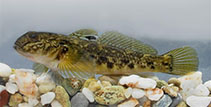 |
| Gobiidae |
Neogobius pallasi
|
(Berg, 1916) | Fr
| native | Caspian monkey goby (English), Belyi bychok (Russian), Kaspiiskii bychok-pesochnik (Russian), Caspian sand goby (English) | | 20.00 cm SL male/unsexed | | Known from the Caspian basin; common in Volga drainage, upriver to Moscow (Ref. 59043). Found in the delta of the Volga River (Ref. 2058). EurRus |  |
| Xenocyprididae |
Ochetobius elongatus
|
(Kner, 1867) | Fr
| not established | охетобиус (Russian) | | 40.00 cm TL male/unsexed | | Recorded for the first time in Lake Khanka (Ref. 26334). Failed to establish self-reproducing population (Ref. 45022). nEurRus | 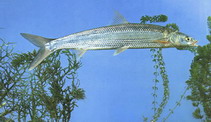 |
| Salmonidae |
Oncorhynchus gorbuscha
|
(Walbaum, 1792) | Fr, Br, M, Fi
| native | Горбуша (Russian), Kraska-balyk (Russian), Pink salmon (English), Ech-ech (Russian), Gorbuscha (Russian), Gorbusha (Russian), Kal'-al' (Russian), Krasnina (Russian), Kykhyl-balyk (Russian), Tengi (Russian), Uru (Russian), горбуша (Russian) | | 76.00 cm TL male/unsexed | | Has been reported in the lower reaches of the Amguena, Kolyma and Indigirka Rivers. Occurs in the Amur River (Ref. 26334). Known from Peter the Great Bay to the Lena River (Ref. 1998), Sakhalin and the maritime province of Siberia and Kamchatka peninsula (Ref. 12218). This has been translocated to areas within the country for stocking in open waters. It has rapidly expanded its range and may now be widely established in the country (Ref. 45022). Has been periodically introduced into the rivers flowing into the Barents and White Seas. In 1956-78, over 200 million eggs were shipped from Sakhalin Islands to Kola Peninsula (Murmansk region) and White Sea; now established in that area (Ref. 59043). Also Ref. 27436, 12218, 27681, 37812, 43202, 55804, 96339, 119200.
EurRus |  |
| Salmonidae |
Oncorhynchus keta
|
(Walbaum, 1792) | Fr, Br, M, Fi, Aq
| native | Кета (Russian), Haiko (Russian), Chum salmon (English), Summer chum (English), Keta (Russian), Letnyaya keta (Russian), Sil'cha (Russian), Vel (Russian), кета (Russian) | common (usually seen) | 100.00 cm FL male/unsexed | | Occurs in the Poronai and Tym' Rivers (Ref. 27681). Found in Sakhalin and Kamchatka (Ref. 37812). Migrates from the Lena River to the Tumannaya River which empties into Peter the Great Bay. This species was introduced into the rivers flowing into the Barents and White seas as well as into the Caspian basin however introduction was not successful (Ref. 26334). Introduction into the Volga drainage failed (Ref. 59043). Commercially cultured in the past (Ref. 7306). Also Ref. 27436, 45022, 96339, 119200.
nEurRus |  |
| Salmonidae |
Oncorhynchus kisutch
|
(Walbaum, 1792) | Fr, Br, M, Fi
| native | Кижуч (Russian), Belaya ryba (Russian), Coho salmon (English), Belaya (Russian), Kizhuch (Russian), кижуч (Russian) | | 108 cm TL male/unsexed ;65.50 cm female | | Spawns in the rivers of Kamchatka, Sahkhalin (Tym River), the Commander and Shantarskie Is. and in rivers along the coasts of the Sea of Okhotsk (Ref. 26334). Occurs in the Anadyr River (Ref. 1998). This has been translocated to areas within the country for aquaculture and stocking in open waters. However, it failed to establish populations in areas where it has been transplanted to (Ref. 45022). Also Ref. 593, 2850, 27436, 27681. nEurRus | 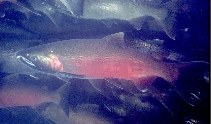 |
| Salmonidae |
Oncorhynchus masou
|
(Brevoort, 1856) | Fr, Br, M
| native | Сима (Russian), Sima (Russian), Masu salmon (English) | | 79.00 cm TL male/unsexed | | Anadromous and land-locked forms are distributed only along western Kamchatka, mouth of the Amur,Tym' and Poronai rivers (Ref. 26334, 593, 27681). Known from Kuril archipelago (Ref. 12218). Sakhalin, western Kamchatka (Ref. 37812). nEurRus | 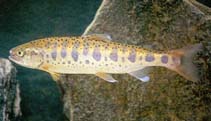 |
| Salmonidae |
Oncorhynchus mykiss
|
(Walbaum, 1792) | Fr, Br, M
| native | Микижа (Russian), Kamchatskaya semga (Russian), Mikizha (Russian), Kamchatka salmon (English), Kamchatka steelhead (English), Kamchatka trout (English), камчатский лосось (Russian) | common (usually seen) | 122 cm TL male/unsexed | | Occurs off the Kamchatka Peninsula and rarely in rivers along the continental coast of the Sea of Okhotsk and in the Amur estuary. The relic land-locked population is found on Bol'shoi Shantarskie I. (Ref. 26334). Enters rivers of the tundra on the western coast as well as the rivers of the eastern coast of Kamchatka and occurs in the Amur Liman, south of the mouth of the Amur (Ref. 593). Enters the rivers of Kamchatka from September to October, spawns in spring, not far from the sea, and migrates back to the sea in May-June (Ref. 593). This has been translocated to areas within the country for aquaculture and stocking in open waters. It has escaped aquaculture facilities and has now locally established self-sustaining populations (Ref. 45022). Recorded from the Lake Imandra where it is introduced (Ref. 34665). EurRus |  |
| Salmonidae |
Oncorhynchus nerka
|
(Walbaum, 1792) | Fr, Br, M, Fi
| native | Нерка (Russian), Karlikovaya nerka (Russian), Sockeye salmon (English), Krasnaya (Russian), Nerka (Russian), Nyarka (Russian), красная (Russian), нерка (Russian) | | 84.00 cm TL male/unsexed ;71.00 cm female | | Both the sockeye and kokanee are known from Siberia (Ref. 27547). Found in Sakhalin (Ref. 37812). Occurs in the Anadyr River, Soldatskaya River (Ref. 43703), the rivers of Kamchatka, the rivers of the Okhotsk and of the Commader Is. (Ref. 593). This has been translocated to areas within the country for stocking in open waters. However, it failed to establish populations in areas where it has been transplanted to (Ref. 45022). Also Ref. 2850, 27436, 8984, 119200.
nEurRus |  |
| Salmonidae |
Oncorhynchus tshawytscha
|
(Walbaum, 1792) | Fr, Br, M, Fi
| native | Чавыча (Russian), Chavycha (Russian), Chinook salmon (English), King salmon (English), чавыча (Russian) | | 150 cm TL male/unsexed | 85.4 | Known to occur in the Anadyr River and rivers of Kamchatka, the Commander Is. and the Amur estuary (Ref. 26334). This has been translocated to areas within the country for stocking in open waters. However, it failed to establish self-sustaining populations (Ref. 45022). Also Ref. 27436, 37812. In range Ref. 2850, 593. nEurRus |  |
| Xenocyprididae |
Opsariichthys bidens
|
Günther, 1873 | Fr
| native | | | 26.10 cm TL male/unsexed | | Known from the Amur River drainage (Ref. 58298). nEurRus | 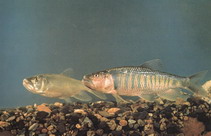 |
| Xenocyprididae |
Opsariichthys uncirostris
|
(Temminck & Schlegel, 1846) | Fr
| native | Triplelip (English), Tregubka (Russian), Troegub (Russian), Three-lips (English), Threelips (English), трегубка (Russian) | | 44.40 cm TL male/unsexed | 10 TL | Inhabits the Ussuri River, Lake Khanka, and the Amur downstream of Blagoveshchensk (Ref. 26334). This has been translocated to areas within the country for unknown reasons where it has locally established self-sustaining populations (Ref. 45022). Also Ref. 1441. nEurRus | 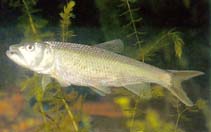 |
| Cichlidae |
Oreochromis aureus
|
(Steindachner, 1864) | Fr
| not established | Тилапия голубая (Russian) | | 45.70 cm TL male/unsexed | | Stocked in captive conditions and escaped into the open waters. Possibly falied to establish a self-sustaining population (Ref. 45022). | 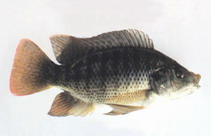 |
| Cichlidae |
Oreochromis mossambicus
|
(Peters, 1852) | Fr, Aq
| introduced | Тилапия мозамбикская (Russian), Mozambikskaya tilapiya (Russian), мозамбикская тиляпия (Russian) | | 39.00 cm SL male/unsexed | | Cultivated in several fish farms and reported in 2000 in the in-take channel of the Krasnodar electric power station. Recorded in Kuban River (Ref. 75639). Also Ref. 57648. EurRus |  |
| Leuciscidae |
Oreoleuciscus humilis
|
Warpachowski, 1889 | Fr
| native | Karlikovyi altaiskii osman (Russian), Altaian dwarf osman (English), Dwarf Altai osman (English), карликовый алтайский осман (Russian), осман карликовый алтайский (Russian) | | 20.00 cm SL male/unsexed | | Occurs in the Chuya River and the northern part of Lake Uvs Nuur with its tributary, the Tesiin Gol (Ref. 26334). nEurRus |  |
| Leuciscidae |
Oreoleuciscus potanini
|
(Kessler, 1879) | Fr
| native | Altaiskii osman (Russian), Altaiskiy osman (Russian), Altai osman (English), Altaian osman (English), алтайский осман Потанина (Russian) | | 100.00 cm TL male/unsexed | | Occurs in lakes and rivers related to the Ob headwaters (Ref. 26334). nEurRus |  |
| Adrianichthyidae |
Oryzias latipes
|
(Temminck & Schlegel, 1846) | Fr
| introduced | медака (Russian), Medaka (Russian), Japanese medaka (English), медака (Russian) | | 4.00 cm SL male/unsexed | | Introduced together with commercially valuable fish species. It was reported from the Kuban basin in 1978 (Ref. 26334). EurRus | 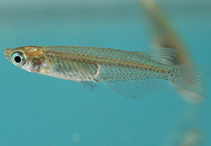 |
| Adrianichthyidae |
Oryzias sinensis
|
Chen, Uwa & Chu, 1989 | Fr
| introduced | | | 3.10 cm SL male/unsexed | | Introduced for stocking in open waters, rapidly expanded its range and has now widely established self-sustaining populations (Ref. 45022). |  |
| Osmeridae |
Osmerus dentex
|
Steindachner & Kner, 1870 | Fr, Br, M
| native | Koryushka (Russian), корюшка зубастая (Russian), огуречник (Russian) | | 34.00 cm SL male/unsexed | 15 FL | Occurs in the White Sea, along the Siberian coast, and Kamchatka. Sakhalin (Ref. 37812). Found also in the basins of the Poronai and Tym' Rivers (Ref. 27681). Also Ref. 55804. nEurRus |  |
| Osmeridae |
Osmerus eperlanus
|
(Linnaeus, 1758) | Fr, Br, M, Fi
| native | Корюшка европейская (Russian), Lake dwarf smelt (English), Koryushka obyknovennaya (Russian), European smelt (English), Sea smelt (English), Sparling (English), Koryushka (Russian), Morskaya koryushka (Russian), европейская корюшка (Russian), корюшка европейская (Russian) | common (usually seen) | 45.00 cm TL male/unsexed | | Occurs in the basins of the White, Barents and Baltic Sea (Ref. 26334). This has been translocated to areas within the country, rapidly expanded its range and is now widely established (Ref. 45022). Also Ref. 4645. EurRus | 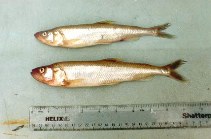 |
| Nemacheilidae |
Oxynoemacheilus merga
|
(Krynicki, 1840) | Fr
| native | Golets Krynitskogo (Russian), Caucasus stone loach (English), Krynicki's loach (English), Merga stone loach (English) | | 10.00 cm SL male/unsexed | | Occurs in the Sulak River (Ref. 26334), Kuma, Terek, Shura-ozen and Samur drainages (Ref. 59043). Also recorded from Rubas drainage (Ref. 59043), at village Syrtych (Ref. 125990). EurRus |  |





















































































